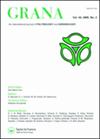来自Pantanal(巴西南马托格罗索州和马托格罗索州)的蜂蜜样品的植物和地理来源
IF 1
4区 生物学
Q4 PLANT SCIENCES
引用次数: 3
摘要
摘要在2003年至2018年的主花期(7月至10月)采集了20份意大利蜜蜂的蜂蜜样品。对马托格罗索州(MT)的六家养蜂场和南马托格罗索州(MS)的三家养蜂场进行了采样。该地区的植被为非洪水、季节性洪水和水生稀树草原,有零星的森林斑块(季节性半落叶林、塞拉多和塞拉多)。为了了解花粉的相对频率,采用非乙酰乙酸裂解法对样品进行了分析。使用主成分分析(PCA)来比较样本之间的相似性。在13个MT蜂蜜样品中,鉴定出来自40科55属的63种花粉类型,以及3种尚未确定的花粉类型。Curatella americana(“lixeira”)和Myracroduon urundeva(“roeira”)的单花MT蜂蜜得到了认可。在7个MS蜂蜜样品中,共鉴定出来自24科32属的40种花粉类型。单花MS蜂蜜包括杨梅、Stryphnodedron adstringens(“arbatimão”)和Richardia(“ernarda”)。分析结果与养蜂人宣布的开花来源不一致。为了确保潘塔纳尔蜂蜜作为PGI(受保护地理标志)在国际贸易中的孢粉学差异,有必要通过花粉学分析对其植物来源进行更严格的控制。本文章由计算机程序翻译,如有差异,请以英文原文为准。
Botanical and geographical origins of honey samples from Pantanal (Mato Grosso and Mato Grosso do Sul states, Brazil) certificated by melissopalynology
Abstract Twenty honey samples of Apis mellifera were collected during the main flowering period (July–October) between 2003 and 2018. Six apiaries in Mato Grosso (MT) state and three apiaries in Mato Grosso do Sul (MS) state were sampled. The vegetation in the region is non-flooding, seasonally flooded and aquatic savanna with scattered forested patches (seasonal semi-deciduous forest, Cerrado and Cerradão). Samples were analysed by non-acetolysed method in order to understand the relative pollen frequencies. A principal component analysis (PCA) was used to compare the similarity between the samples. Within the 13 MT honey samples, 63 pollen types from 55 genera and 40 families were identified, as well as three undetermined pollen types. Monofloral MT honey of Curatella americana (‘lixeira’) and Myracrodruon urundeva (‘aroeira’) were recognised. In the seven MS honey samples, a total of 40 pollen types from 32 genera and 24 families were identified. Monofloral MS honey included Myracrodruon urundeva, Stryphnodendron adstringens (‘barbatimão’) and Richardia (‘bernarda’). The results of the analyses did not correspond to the flowering sources declared by the beekeepers. To ensure the palynological differentiation of Pantanal honey required by international trade as PGI (Protected Geographical Indication), a greater control over its botanical origin is necessary, through melissopalynological analysis.
求助全文
通过发布文献求助,成功后即可免费获取论文全文。
去求助
来源期刊

Grana
生物-植物科学
CiteScore
2.10
自引率
11.10%
发文量
23
审稿时长
>12 weeks
期刊介绍:
Grana is an international journal of palynology and aerobiology. It is published under the auspices of the Scandinavian Palynological Collegium (CPS) in affiliation with the International Association for Aerobiology (IAA). Grana publishes original papers, mainly on ontogony (morphology, and ultrastructure of pollen grains and spores of Eucaryota and their importance for plant taxonomy, ecology, phytogeography, paleobotany, etc.) and aerobiology. All submitted manuscripts are subject to initial appraisal by the Editors, and, if found suitable for further consideration, to peer review by independent, anonymous expert referees. All peer review is single blind and submission is online via ScholarOne Manuscripts.
 求助内容:
求助内容: 应助结果提醒方式:
应助结果提醒方式:


